Sensoji Temple is one of the most popular tourist destinations in Tokyo, attracting millions of tourists and local people to visit and pray every year.
The most famous sightseeing of Sensoji Temple is the magnificent red Kaminarimon Thunder Gate, which is also a typical check-in point for most tourists when visiting Tokyo.
However, as you step inside the temple grounds, you will realize that Sensoji Temple also has many unique and beautiful architectural structures.
In this article, I will introduce the 6 most famous sightseeings at Sensoji Temple.
Please read on to make your visit to Sensoji Temple more complete and meaningful.
History of Sensoji Temple
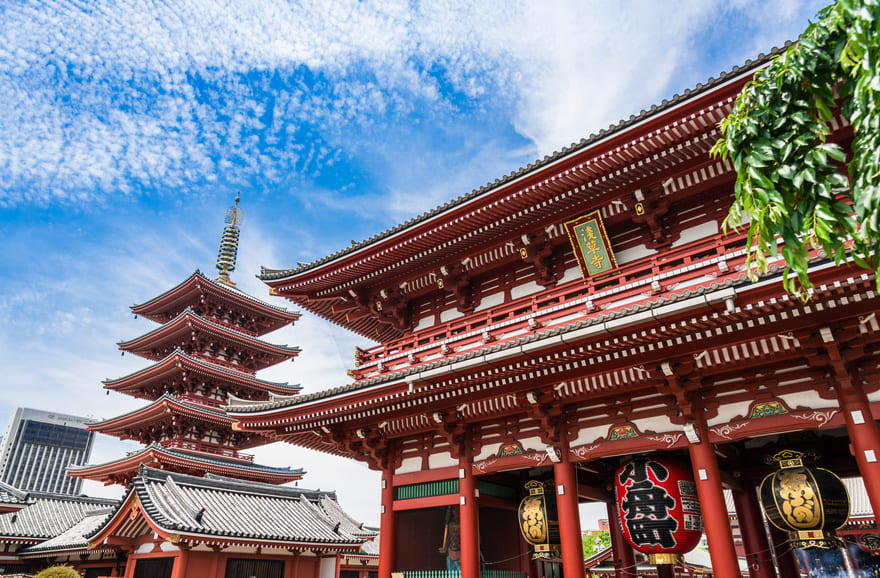
Sensōji Temple (浅草寺), also known as Asakusa Kannon Temple (浅草観音), is a place of worship dedicated to the Bodhisattva Avalokitesvara.
Located in the Asakusa neighborhood, Sensōji Temple was built in the 7th century and is considered the oldest temple in Tōkyō.
According to legend, in 628, while fishing on the banks of the Sumida River, the Takenari brothers came across a statue entangled in a net.
Not knowing it was a Buddha statue, the two brothers threw it back into the river and tried to re-seed the net several times, but each time they only caught the Buddha statue but did not catch any fish.
Then they brought this statue to the village chief to see. This man realized that it was a statue of Bodhisattva Avalokitesvara, so he built a small temple to worship.
This is also the origin of the present Sensōji temple.
Over the course of more than 1,400 years of history, Sensōji Temple has been heavily damaged by earthquakes, fires and war many times, but thanks to the support of the Emperor and followers, the temple has been restored.
Today, Sensōji Temple is one of Tōkyō’s most popular tourist attractions, attracting millions of visitors each year to visit and pray.
Top 6 most popular sightseeings in Sensōji Temple
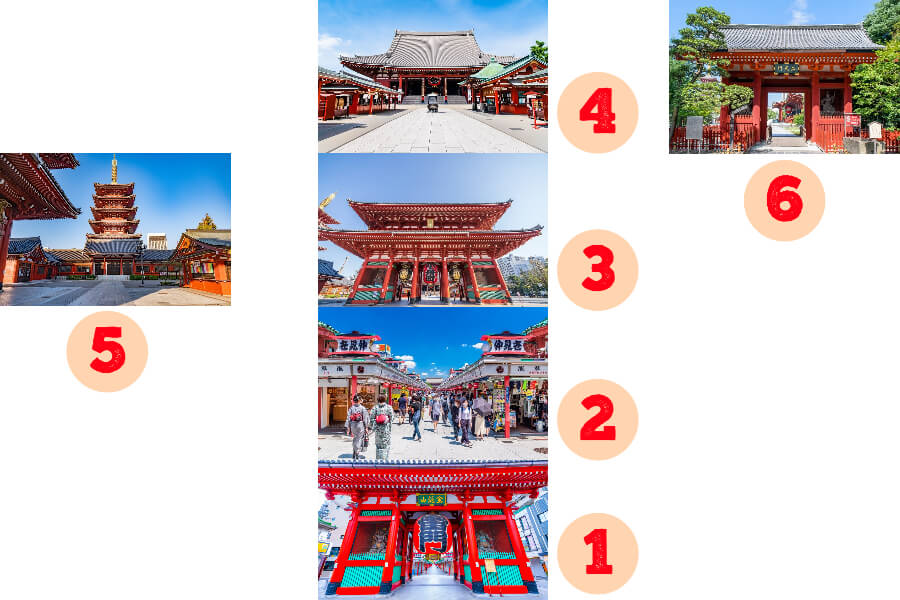
Sensōji Temple is a collection of many beautiful structures imbued with Japanese identity.
Start your tour of Sensōji Temple from Kaminari-mon Gate (1), go through Nakamise-dōri shopping street (2), reach Hōzō-mon Gate (3), and enter Kannon-dō Main Hall (4).
In addition, the Gojūnotō tower (5) and the Niten-mon gate (6) inside the temple grounds are also must-see attractions.
Sightseeing 1: Gate of Thunder God Kaminari-mon (雷門)
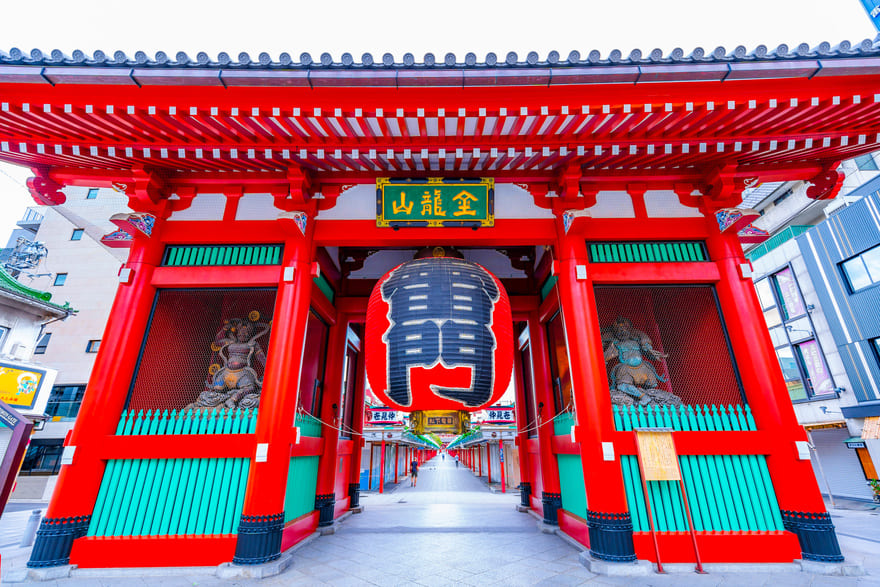
Kaminari-mon Gate is the main gate of Sensōji Temple.
Not only is it the symbol of Sensōji Temple, it is also one of the most famous symbols in Tokyo.
Although commonly known as “Kaminari-mon” (meaning “Gate of Thunder”), its official name is Fūraijin-mon (風雷神門, literally “Gate of the Wind and Thunder God”).
When visiting the gate, you can see statues of God of Wind and God of Thunder placed on either side.
The most prominent feature of the Kaminari-mon gate is the giant red lantern 3.9m high, weighing 700kg, with the word “雷門” written on it.
This lantern was donated by the founder of Panasonic Corporation – Mr. Kōnosuke Matsushita in 1960 and is restored every 10 years.
In addition, at the back of Kaminari-mon gate (right behind the God of Wind and God of Thunder) there are 2 statues of God Tenryu and God Kinryu.
These are the Dragon deities who govern the water source and are also the guardian deities of Sensōji Temple.
Sightseeing 2: Nakamise-dōri Shopping Street (仲見世通り)
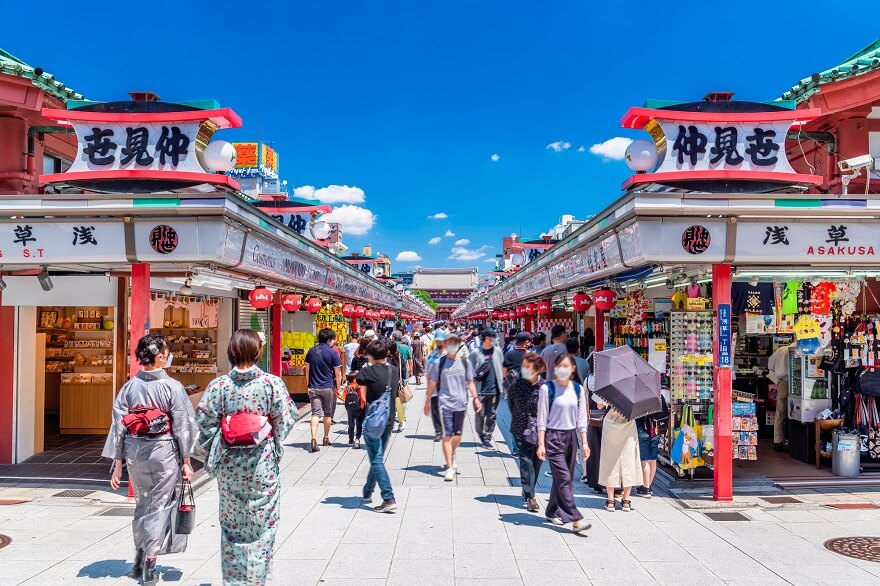
Through the Kaminari-mon gate, you will enter Nakamise-dōri street, one of the oldest shopping streets in Japan.
The Nakamise-dōri shopping street is said to have been born around 1685, when local residents in charge of cleaning up areas inside the temple were allowed to open a shop in return.
Although only about 250m long, Nakamise-dōri street has 90 shops.
Souvenirs, toys and traditional Japanese snacks… you will be overwhelmed by the variety of shops here.
Note that the Nakamise-dōri shopping street does not allow visitors to eat while walking, so if you want to try a certain dish, you should stop and eat in a place where there are few people.
Sightseeing 3: Gate of Treasure Hōzō-mon (宝蔵門)
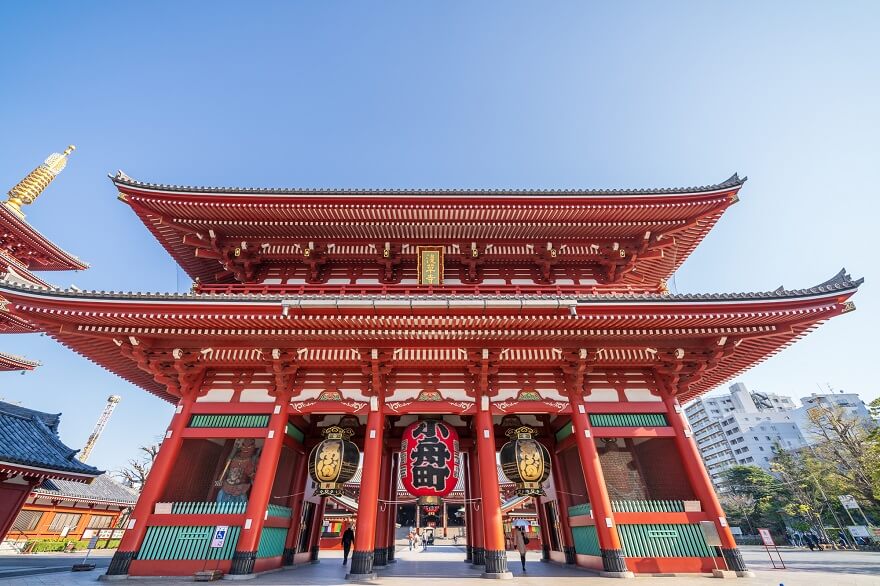
After passing through the Kaminari-mon gate and walking through the bustling Nakamise-dōri street, a majestic vermilion gate will greet you.
This is the Hōzō-mon Gate, the second gate leading to Sensōji Temple.
Called a gate, but Hōzō-mon is designed as a house with a height of nearly 22m, more than 20m in length and consists of 2 floors.
The upper floor of the Hōzō-mon gate houses many rare scriptures that have been designated an Important Cultural Property of the Nation.
Thus, the name Hōzō-mon (meaning “treasure gate”) was born.
On the left and right sides of the gate are statues of 2 Niō gods (Diamond Protectors) made of rare Kisohinoki wood, each weighing up to 1,000kg.
Also don’t forget to look out for the giant straw sandals on the back of the gate.
Using more than 2,500kg of straw to braid, each straw sandal is up to 4.5m long and weighs nearly 500kg.
The straw sandals symbolize the power of God Niō, it is said that demons will have to leave in terror when they learn that the god wearing such a large straw sandal is guarding this temple.
Sightseeing 4: Main Hall Kannon-dō (観音堂)
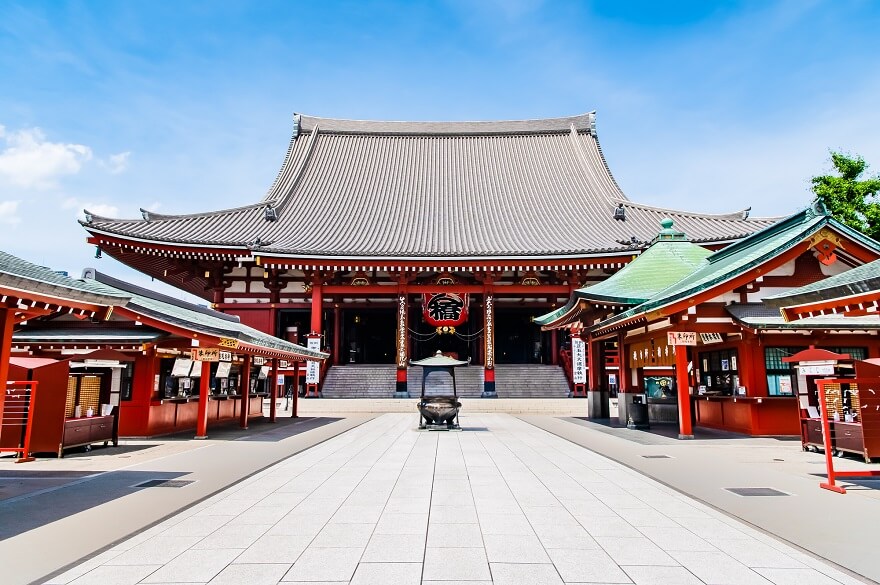
Passing through the Hōzō-mon gate is the Kannon-dō Main Hall (meaning “The Palace of Guan Yin”) – which was recognized as the “National Treasure” in 1907.
The main hall has been damaged many times in its history and has also been rebuilt many times. According to the documents, the Main Hall has been reconstructed nearly 20 times.
The most obvious feature of the Main Hall is that the roof slopes significantly higher than the roofs of other temples.
The main hall is divided into two areas: the outer shrine (外陣, Gejin) and the inner shrine (内陣, Naijin).
You can enter both areas, but remember to take off your shoes before entering the inner shrine.
The statue of Bodhisattva Avalokitesvara is placed inside a small shrine right in the middle of the inner shrine.
In fact, at Sensōji Temple, there are 2 statues of Bodhisattva Avalokitesvara enshrined.
One is the legendary statue of Bodhisattva Avalokitesvara, which is a secret Buddha image, so it is always kept strictly and no one can see it.
The second is the statue of Bodhisattva Avalokitesvara replacing the secret Buddha image, which will be made public once a year at 2pm on December 13.
Of course, it would be great to see the statue of Guan Yin Bodhisattva, but if you can’t go at the right time, don’t miss seeing the beautiful Main Hall of Sensōji Temple.
Sightseeing 5: The Five-Storied Pagoda Gojūnotō (五重塔)
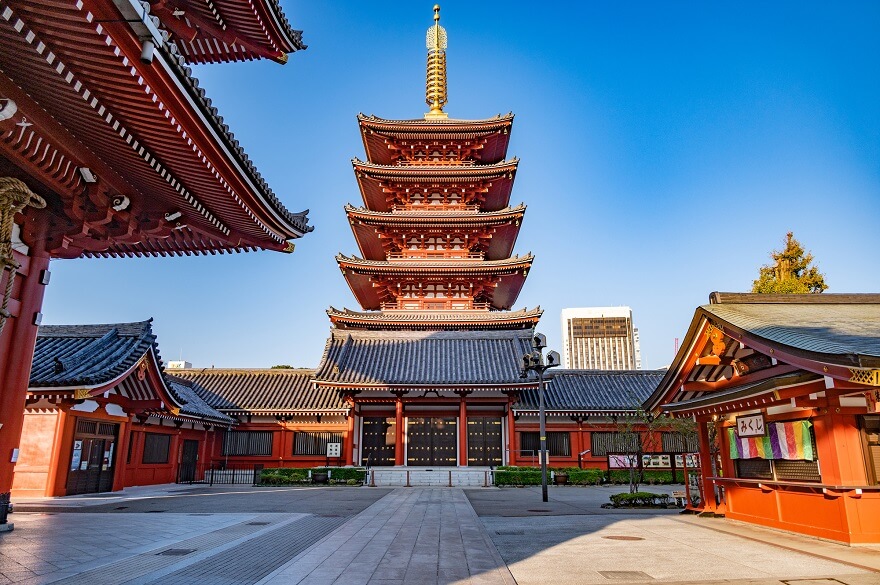
Gojūnotō is a very famous tower located on the grounds of Sensōji Temple.
Gojūnotō was first built in 942 but burned down in 1945 due to war.
The tower we see today was rebuilt in 1973 with donations from believers around the country.
Gojūnotō consists of 5 floors painted in a striking vermilion color.
The top floor houses the relics of the Buddha donated by Isurumuniya temple in Sri Lanka in 1966.
Since ancient times, the Gojūnotō tower has been an indispensable motif in paintings depicting Asakusa and Sensōji Temple.
If you have the opportunity to visit Sensōji temple, do not forget to take souvenir photos with Gojūnotō tower.
Sightseeing 6: Gate of the Two Gods Niten-mon (二天門)
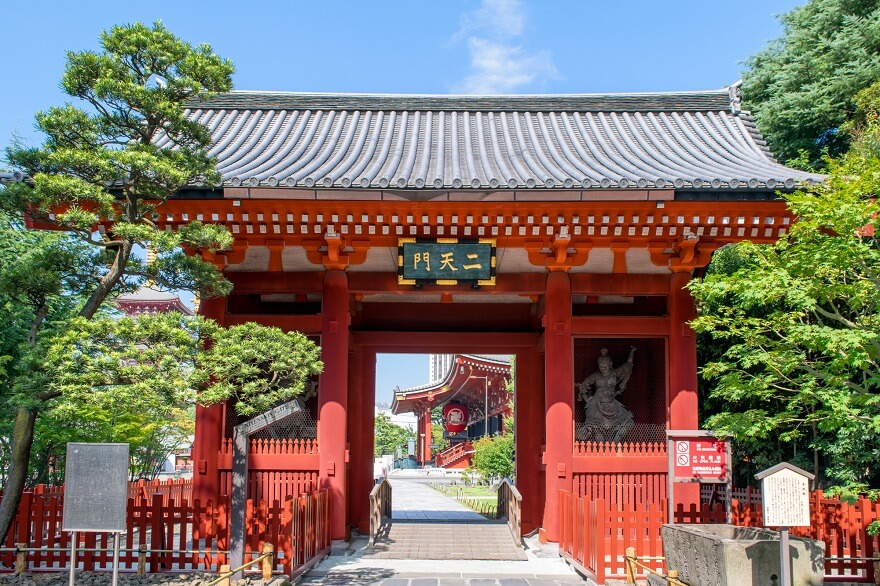
Niten-mon is a gate located on the east side of Sensōji Temple (to the right of Kannon-dō seen from the front).
Niten-mon in Japanese means “gate of the two Buddha gods” because the left and right sides of the gate have statues of the two guardian Buddha gods, Zōchōten (増長天) and Jikokuten (持国天).
The Niten-mon Gate was first built in 1649.
After many restorations over the course of hundreds of years, in 2010, the gate was restored to its original shape.
The Niten-mon Gate has been designated a National Important Cultural Property and is the perfect place to take a slow look at the ancient architecture of the Edo period.
Instructions on how to get to Sensōji Temple
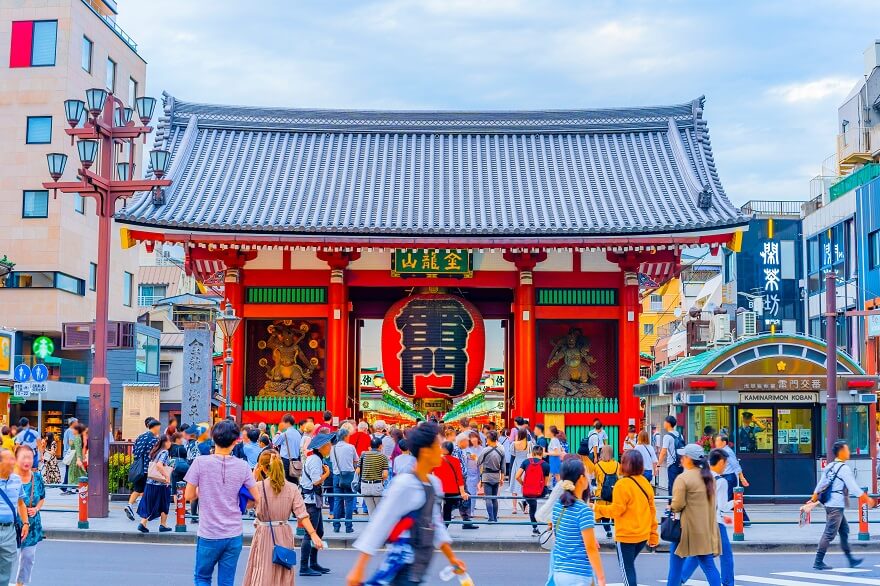
Sensōji Temple is located closest to Asakusa Station, just a 5-minute walk from the station.
You can reach Asakusa Station by many train lines, depending on the train line, the exit to Sensōji Temple will be different.
- To Asakusa Station by Tobu Skytree Line: Exit EKIMISE
- To Asakusa Station by Tokyo Metro Ginza Line: Exit 1
- To Asakusa Station by Toei Subway Asakusa Line: Exit A4
- To Asakusa Station by Tsukuba Express: Exit A1
Sensōji Temple (浅草寺)
Homepage: https://www.senso-ji.jp/english/
Access: 5 minutes walking from Asakusa Station
Open hours:
・Outside Main Hall: 24/24
・Main Hall (April~September): 6:00~17:00
・Main Hall (October ~March): 6:30~17:00
Admission price: free
Map:
Conclusion
Above are the 6 most popular attractions in Sensōji Temple.
Not only the Kaminarimon Thunder God Gate or the Kannon-dō Main Hall can be seen, all the structures inside Sensōji Temple have their own beauty and play an important role in shaping the appearance of the temple.
Hopefully this article will help you have a clearer picture of Sensōji Temple so that you can fully experience it when you have the opportunity to visit the temple.


Comment